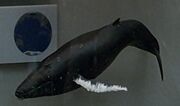Humpback whales (Megaptera novaeangliae) were a type of intelligent cetacean lifeform, baleen whales, native to the planet Earth. In the Russian language, they were known as vessyl kit - the 'merry whale'.
Biology
A mature humpback whale measured an average of 18 meters long and weighed about 40 tons. 12 meter juveniles weighed approximately 20.5 tons. They were a dark blue-black in colour with long white pectoral fins.
History
In 1756, the humpback whale species was first identified by Mathurin Jacques Brisson. (Starfleet Academy SCISEC Briefs episode: "SCISEC Brief 004: The Whale Probe")
In 18th century, there were many hundreds of thousands of humpback whales in Earth's oceans, unfortunately in the following years, over-hunting reduced their population severely.
In 1846, the species was classifed under the genus Megaptera. (Starfleet Academy SCISEC Briefs episode: "SCISEC Brief 004: The Whale Probe")
By the 1980s, less than 7,000 humpback whales were thought to exist in the wild. The Cetacean Institute in Sausalito, California, temporarily housed two humpbacks, a male and a female, after they swam into San Francisco Bay as calves. Named George and Gracie, and under the care of Assistant Director Gillian Taylor, the whales grew into young adults with Gracie eventually becoming pregnant.
In 1985, Dr. Taylor observed a pod of humpback whales off the coast of Alaska. One of the whales, a female, played with a sea lion and came within close proximity of the researchers' boat. Taylor was convinced the whale was listening to music by Emmylou Harris that they were playing.

A model of a humpback whale in the Cetacean Institute.
In 1986, George and Gracie were due to be released into the wild so Gracie could give birth. However, they, and Dr. Taylor, were taken into the future by Admiral James T. Kirk and his crew to communicate with a Cetacean Probe that was devastating Earth in 2286.
In the 21st century, along with the other great whales, humpbacks had been hunted to extinction.
In 2275, while undertaking a spacewalk from the Enterprise in intergalactic space, Captain Kirk recalled encountering a humpback whale whilst night diving off the northern California coast. (TOS novel: The Wounded Sky)
- As humpbacks were still extinct in 2275, this recollected experience could have been from a simulation; brought about by the testing of the inversion drive; or something that happened in an alternate reality or timeline.
Under the supervision of Dr. Taylor, the humpback whale species was reintroduced in the late-23rd century, beginning with George, Gracie and their son, Harpo. (TOS movie, novelization & comic adaptation: Star Trek IV: The Voyage Home; TOS short story: "The Hero of My Own Life")
Known humpback whales
| This article or subsection has an associated category. | Humpback whales |
|---|
Appendices
Connections
| Earth cetacean species | |
|---|---|
| Baleen whales | blue whale • fin whale • gray whale • humpback whale • minke whale • right whale • sei whale |
| Toothed whales | Atlantic bottlenose dolphin • Baird's beaked whale • Cuvier's beaked whale • pilot whale • orca • Pacific bottlenose dolphin • pygmy sperm whale • sperm whale • Takaya's whale |
External links
- Humpback whale article at Memory Alpha, the wiki for canon Star Trek.
- Humpback whale article at Wikipedia, the free encyclopedia.
